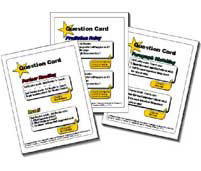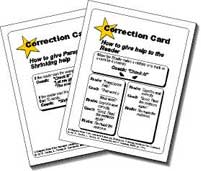How can Mrs. Nash implement these activities?
Page 8: Prepare Materials
Before she trains her students to use PALS, Mrs. Nash wants to make certain that all of her materials and resources are in place. Although premade PALS materials are available, Mrs. Nash creates many of the materials herself and displays them on a bulletin board so that her students can have immediate access to relevant information. The bulletin board below is the one created by Mrs. Nash. Click on each item on the board to view its content in closer detail.
Pre-made PALS Materials
A wide variety of pre-made PALS materials are available for purchase at https://frg.vkcsites.org/what-is-pals/
If you have questions about PALS materials or the ordering process, please direct them to: [email protected]
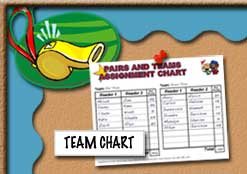 |
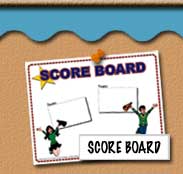 |
 |
|
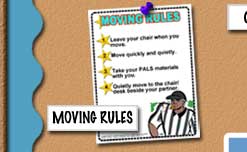 |
 |
 |
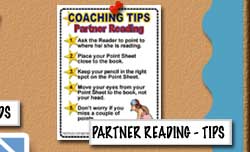 |
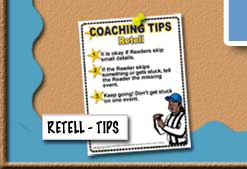 |
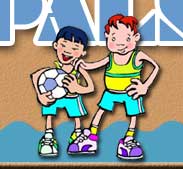 |
 |
|
In addition to the items on the bulletin board, Mrs. Nash needs a timer (e.g., a stopwatch) with which to monitor the length of the three activities and to let her students know when to switch roles, as well as a calculator to help her tally the weekly points. As she prepares materials for her students, Mrs. Nash first considers the type of books that she will select for the pairs. She now knows that:
- Any reading material can be used (e.g., reading textbooks adopted by the school, novels, library books, content-area books).
- The text can be either narrative or expository.
- Texts should reflect the reading level of the weaker reader (i.e., the weaker reader should be able to read the text with no more than 10 errors for every 100 words).
- The reading material may be individualized so that all pairs are not reading the same text.
Fritz and the Beautiful Horses
Once there was a walled city known for its beautiful horses. The citizens were so proud of these horses that they passed a law that allowed only the most beautiful horses into the city. All others had to stay outside. One of these was a pony named Fritz.
Fritz was not beautiful. He had a long, tangled mane, whiskers on his muzzle, and short legs. But Fritz was very gentle and kind. He was sure-footed and always willing to work.
Day after day, hour after hour, Fritz watched the beautiful horses leaping and prancing. Most of all, he watched the children’s horses. As Fritz watched he thought, “I would like a child to ride me.” But no one ever noticed Fritz.
One day, the people of the walled city went for a ride on their horses outside of the city walls. They galloped and pranced and leaped. Fritz watched patiently, hoping someone would notice him. No one did.
After a while, the people of the city grew tired and started galloping back toward the walled city. They rode onto the great bridge leading to the walled city.
All of a sudden Fritz heard a loud snap. The bridge was breaking. Fritz saw the bridge break in half. The people of the city were on one side and the children were left on the other side. “You’ll have to cross through the river,” cried the people.
(From Peer Assisted Learning Strategies: Reading Methods for Grades 2PALS: A Reading Strategy for Grades 2–66, by D. Fuchs, L. S. Fuchs, D. Simmons, and P. G. Mathes, 2008, p. 249.)
Devin Kearns makes some suggestions for choosing appropriate reading material for student pairs (time: 1:17).

Devin Kearns, MA
PALS trainer
Vanderbilt University
Transcript: Devin Kearns, MA
One important thing in PALS is to choose books for students that they can read—especially the lower-performing student in the pair can read—and this can be a little bit tricky. So this is where your CBM data or state test data can be very helpful to you, because it allows you to choose books at an appropriate level for the lower-performing student. It’s really important that you don’t choose books that are too hard. What I would actually recommend is that if you had to make a choice about a book that is a little bit too easy or a little bit too hard, choose the book that is a little bit too easy—provided that it is not way too easy, and that it’s a book that will be of interest to the students. And the reason I say that is that we have found in the past that when teachers really push their students to try to read books that are too difficult for them, they miss so many words that they really can’t actually get into the text very well, and so then they have a really hard time making main ideas statements and doing the comprehension related activities in PALS. They’re not going to get any benefits out of the PALS activities, and they’re going to get frustrated, and they may not end up liking PALS. So you want to choose books that are at the right level, and then you can just monitor them to make sure that the books are working okay for them.
Next, Mrs. Nash prepares the Question Cards, Correction Cards, and the Point Sheet that her students will keep in their PALS folders. Click on illustrations below for printable versions of each.
Listen as Devin Kearns discusses the importance of the cue cards (time: 0:29).

Devin Kearns, MA
PALS trainer
Vanderbilt University
Transcript: Devin Kearns, MA
When you teach students at the beginning of PALS how to set up for PALS, at that time you explain to them they always have to have out their PALS materials. And that means getting out their Correction Card and their Question Card. Those cards are really great about reminding students about how to do all the different things, including how many points to mark and things like that. And so students will really rely on this at the beginning. By the end of PALS, students will have out the cards as a reference in case they forget things, but they won’t use them very often.
